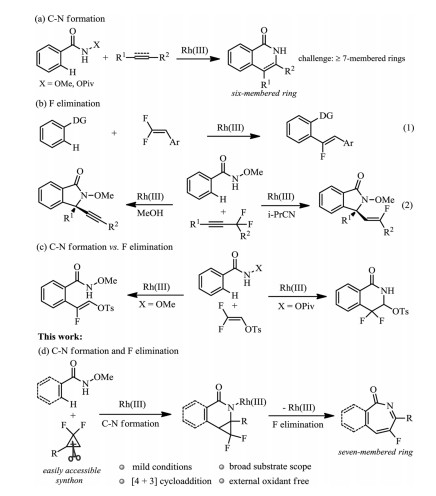
Citation:
Jin Xia LIU, Ru Dong YANG. SYNTHFSIS AND CHARACTERIZATION OF LANTHANIDE COMPARTMENTATL COMPLEXES, Ln2[H2 (BAA)2 en]3·pH2O[J]. Chinese Chemical Letters,
;1993, 4(7): 645-648.

-
A series of new complexes of formula Ln2[H2(BAA)2en]3nH2 Otwhere Ln-La,Pr, Eu, Cd, Dy, Er, Yb, n-1-4) have been prepared by the reaccLon of lanthanide ions with acycllc compartmental ligand N, N'-bis(benzoylacetylacetone)ethylenediamine(H4(BAA)2 en) in methanol.IR and UV spectra, as well as TC DAT analysis prove that the ligand and the Lanthanide ions have coordinated.The coordination number is 12 and the complexes may be of double sandwiched structure.
-
Transition metal-catalyzed C-H bond functionalization reactions are among the most straightforward and atom-economic synthetic methodologies for the construction of complex molecules [1-4]. Typically, a directing group is need to facilitate a regioselective C-H activation event. And the use of oxidizing directing group has received tremendous attentions by offering enhanced reactivity and eliminating the employment of external oxidant [5-12]. In this respect, various five- and six-numbered rings are mildly and effectively constructed through the oxidizing directing group strategy. For example, an elegant seminal work from Fagnou reported a Rh(Ⅲ)-catalyzed redox-neutral annulation of benzhydroxamic acids with alkynes towards the synthesis of isoquinolone derivatives by using N-O bond as a built-in oxidant (Scheme 1a) [13]. However, since the eight- membered rhodacycle intermediates are energetically unstable, utilizing this tactics to construct seven-membered rings is elusive [14, 15].
Scheme 1
 Scheme 1. Rhodium-catalyzed C─H activationreactions toward the organofluorines with an oxidizing directing group.
Scheme 1. Rhodium-catalyzed C─H activationreactions toward the organofluorines with an oxidizing directing group.Fluorinated organic molecules have attracted significant attention in drug discovery and agricultural chemistry due to their unique physicochemical and bioactivity properties [16-18]. Traditional methods for the incorporation of fluorine into the molecules often suffer from the need of substrate pre-activation, the use of non-readily available starting materials, low regio- or stereo-selectivity and/or poor functional group tolerance due to the employment of sensitive reagents [19-21]. Compared with the above-mentioned protocols, transition metal-catalyzed C-H/C-F bond activation assisted by a directing group provides a concise and reliable alternative in an atom- and step-economic pattern. In this context, the group of Loh reported a RhⅢ-catalysed tandem C-H/C-F activation for the synthesis of (hetero)arylated monofluoroalkenes using gem-difluoroalkenes as electrophiles (Scheme 1b-1) [22-24]. The group of Wang disclosed a solvent-dependent enantioselective synthesis of alkynyl and monofluoroalkenyl isoindolinones by asymmetric CpRhⅢ-catalyzed C-H activation with α, α-difluoromethylene alkyne as the substrate (Scheme 1b-2) [25-28]. In these two cases, metal-mediated β-fluorine elimination was observed as key step. Previously, we discovered that different directing groups (N-OMe and N-OPiv amides) enabled dictate the selectivity of C-N formation versus β-F elimination with 2, 2-difluorovinyl tosylate as a substrate (Scheme 1c) [29-33]. With N-OMe benzamide being a directing group (DG), the reaction delivered a monofluorinated alkene with the retention of the tosylate functionality. When N-OPiv benzamides were used, however, [4 + 2] cyclization occurred to provide gem-difluorinated dihydroisoquinolin-1(2H)-ones.
Herein, we report a rhodium-catalyzed formal [4 + 3] cycloaddition reaction of N-methoxybenzamides with easily accessible gem-difluorocyclopropenes [34-49]. The reaction allows the formation of highly functionalized fluorinated 2H-azepin-2-one frameworks with excellent regioselectivity and functional group tolerance (Scheme 1d). Some interesting features of the transformation include: i) Both C-N bond formation and fluorine elimination occur in the reaction with N-OMe as an internal oxidant; ii) The combination of [4 + 2] cycloaddition and retro-[2 + 1] strategy eliminates the formation of eight-membered rhodacycle, thereby providing a feasible and reliable route for the construction of seven-membered aromatic heterocycles; iii) This reaction proceeds under rather mild conditions, and a series of bioactive fluorinated 2H-azepin-2-one derivatives (Fig. 1) [50-52] are obtained in moderate to good yields.
Figure 1
The reaction was initially investigated by using N-methoxybenzamide 1a and gem-difluorocyclopropene 2a as model substrates, [Cp*RhCl2]2 as catalyst and K3PO4 as base in CH2Cl2 at 50 ℃ under argon atmosphere. To our delight, the desired product 3a was obtained in 41% yield (Table 1, entry 1). Solvent screening revealed that only chlorinated alkanes promoted the transformation, with 1, 1, 2, 2-tetrachloroethane being the solvent of choice to give a high yield of to 82% (Table 1, entries 2–7). Replacing [Cp*RhCl2]2 with Cp*Rh(OAc)2 led to a reduced yield of 61% (Table 1, entry 8). The reaction did not proceed with other transition metal catalysts such as [Cp*IrCl2]2, [RuCl2(p-cymene)]2 and [CoCp*(CO)I2] (Table 1, entries 9–11). Other inorganic bases were also subsequently used in the reaction, however, the yield of 3a was not further improved (Table 1, entries 12–16).
Table 1
With optimized conditions in hand, we set to examine the scope. As shown in Scheme 2, the aromatic amide substrates bearing electron-donating (such as Me, t-Bu, OMe and N(CH3)2) and electron-withdrawing substituents (such as Ac, CN, NO2, CF3, CO2Me) at para position underwent reaction smoothly, delivering the cyclized products 3a-3f and 3k-3o in good yields. Substrates bearing halogen substituents were also compatible well (3g-3j), thus providing valuable handles for follow-up transformations. When meta-substituted N-methoxyamide 1p was used, the rhodation occurred at the less hindered site to provide exclusively the C-6 substituted regioisomer (3p). Specially, the 2-methyl substituted substrate did not retard the process (3q), although the yield was slightly reduced. To further highlight the synthetic versatility of our method, several substrates derived from complex natural products and drugs were also subjected to the reaction and the corresponding fluorination products were obtained without difficulty (3s-3v). Furthermore, various alkenyl amides with 2-alkyl substitution were also feasible substrates, producing the products 3w-3aa in moderate yields. Out of our expectation, N-methoxy-2-phenylacrylamide showed no reactivity in the protocol. To demonstrate the scalability of this methodology, the reaction of 1a with 2a was performed on 10 mmol scale, affording 76% yield of the product 3a.
Scheme 2
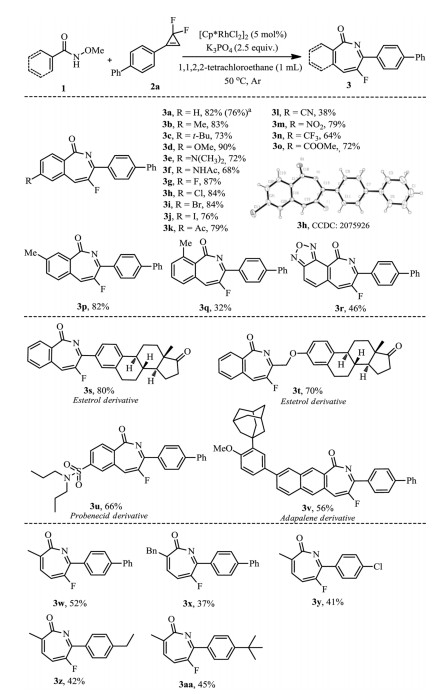 Scheme 2. Substrate scope on amides. Reaction conditions: 1 (0.2 mmol), 2 (0.24 mmol), [Cp*RhCl2]2 (5 mol%), K3PO4 (2.5 equiv.), 1, 1, 2, 2-tetrachloroethane (1 mL) at 50 ℃ under argon atmosphere for 12 h. Isolated yield. a 1a (10 mmol), 2a (12 mmol), [Cp*RhCl2]2 (5 mol%), K3PO4 (2.5 equiv.), 1, 1, 2, 2-tetrachloroethane (10 mL) at 50 ℃ under argon atmosphere for 12 h.
Scheme 2. Substrate scope on amides. Reaction conditions: 1 (0.2 mmol), 2 (0.24 mmol), [Cp*RhCl2]2 (5 mol%), K3PO4 (2.5 equiv.), 1, 1, 2, 2-tetrachloroethane (1 mL) at 50 ℃ under argon atmosphere for 12 h. Isolated yield. a 1a (10 mmol), 2a (12 mmol), [Cp*RhCl2]2 (5 mol%), K3PO4 (2.5 equiv.), 1, 1, 2, 2-tetrachloroethane (10 mL) at 50 ℃ under argon atmosphere for 12 h.The substrate scope for gem-difluorocyclopropenes was also explored (Scheme 3). It was found the reaction was not sensitive to the electron nature of the substituents on the aryl ring, as a diverse of substituents such as Me, n-Pr, F, Cl, Br, CF3, NO2 and CO2Me well survived in the reaction (3ab-3al). Interestingly, higher yields were obtained for meta-substituted aryl gem-difluorocyclopropenes (3ai-3al). The observed higher bench stability of meta-substituted aryl gem-difluorocyclopropenes could be a reason for this result. Not unexpectedly, substrates with other aromatic heterocycles, for example, thiochroman, pyridine, thiophene and benzoxazole were also tolerant, obtaining the products 3an-3aq in 44%−65% yields. It was intriguing that alkyl-substituted gem-difluorocyclopropenes were also compatible (3ar-3av), greatly expanding the diversity of the title reaction.
Scheme 3
Also interesting was the applicability of N-methoxybenzothioamide 4 in the reaction. The cyclization reaction proceeded smoothly to give the desired product 5 in 73% yield (Scheme 4).
Scheme 4
When N-methoxy-2-naphthamide 6 was used in the reaction, the 3-position C-H bond with less steric hindrance was exclusively functionalized to give the product 7 in 72% yield (Scheme 5a). Interestingly, treatment of N-methoxybenzo[d][1, 3]dioxole-5-carboxamide 8 with 2a provided the 4-position annulation product 9 in 78% yield (Scheme 5b). The later could be explained by a coordination effect between the oxygen atom at the 3-position and the transition metal.
Scheme 5
Intermolecular competitive reactions were performed to understand the reactivity of N-methoxybenzamides and gem-difluorocyclopropenes (Scheme 6). Treatment of N-methoxybenzamide 1a and N-methoxybenzothioamide 4 with 2a under the standard conditions gave only 3a in 80% yield (Scheme 6a). Competition reaction of 4-methoxy-N-methoxybenzamide 1d and 4-acetyl-N-methoxybenzamide 1k with 2a gave exclusively 3k in 76% yield (Scheme 6b). This result demonstrated that the benzamide substrates with electron-donating substituents are less reactive. Furthermore, when 1a was treated with 2ac and 2ah, the corresponding products 3ac and 3ah were isolated in 13% and 68% yields, respectively, suggesting that electron-poorer 2ah is good for the reaction (Scheme 6c).
Scheme 6
To further probe the mechanism, several control experiments were conducted (Scheme 7). When D2O was added to the reaction in the absence of 2a, a 47% deuterium incorporation at ortho position of 1a was observed without N-O bond cleavage (Scheme 7a). And a kinetic isotope effect (KIE) value of kH/kD = 1.3 was observed (Scheme 7b). These results suggested that the C-H bond cleavage is reversible and not be involved in the turnover-limiting step. A hydroamination product 10 was unexpectedly obtained in the absence of rhodium catalyst (Scheme 7c). However, this compound was demonstrated not to be an effective intermediate for the title reaction. A rhodacycle Rh-1 was prepared and its intermediacy in the reaction was confirmed by stoichiometric and catalytic reactions, suggesting a C-H activation took place.
Scheme 7
To further cast light on the mechanism, theoretical calculations were performed at the density functional theory level (B3LYP). For the convenience of calculation, the active catalyst Cp*Rh(OAc)2 was chosen as the starting point (zero value of energy). Using N-methoxy benzamide 1a as a substrate, N-H deprotonation followed by C-H activation were performed via a concerted metalation-deprotonation (CMD) mechanism with acetate acting as intramolecular base, through transition states TS-1 (ΔG‡ = 13.0 kcal/mol) and TS-2 (ΔG‡ = 19.8 kcal/mol), respectively (Fig. 2). The intermediate verification experiments in Scheme 7c echoed the calculation results. Thereafter, the insertion of gem-difluorocyclopropene 2ai into the rhodacycle INT-5 presented two characteristic spatial arrangements, TS-3 (ΔG‡ = 27.5 kcal/mol) and TS-3′ (ΔG‡ = 28.9 kcal/mol), both of which had a higher activation barrier than the first two steps (Fig. 3). The computational results indicated that C-H activation was not the turnover limiting step in the reaction, consistent with the observed small experimental KIE values (Scheme 7b). Taking into account the higher energy barrier of TS-3′, especially TS-4′, therefore subsequent calculations revolved around TS-3. From INT-7, the priority of either β-fluorine elimination or C-N bond formation was discussed. The results revealed that the direct β-fluorine elimination with or without the assistance of acetic acid, followed by C-N bond formation step via TS-4a and TS-4b, featured a high energy barrier of 33.2 and 35.1 kcal/mol, reaspectively. Two possible pathways for C-N bond formation prior to the defluorination were then calculated. Considering the high energy barrier of TS-4c (ΔG‡ = 68.6 kcal/mol), the direct migration of the methoxy group from the amide to the trivalent rhodium to form INT-9c was tough. The migration process was more reasonable in the assistance of acetic acid, because the energy barrier of TS-4 was reduced to 28.8 kcal/mol and a Rh(Ⅴ) intermediate INT-10 was produced with the free-energy of −54.3 kcal/mol. the synergistic effect of rhodium and acetate accelerated the ring-opening defluorination of INT-10 to release the final product 3ai (ΔG‡ = −71.0 kcal/mol). Overall, the computed Gibbs free-energy changes of the reaction pathway demonstrated a redox-neutral Rh(Ⅲ)-Rh(Ⅴ)-Rh(Ⅲ) catalytic cycle for the developed protocol involving HOAc-prompted oxidative addition and unprecedented C-F bond cleavage/ring expansion processes.
Figure 2
Figure 3
On the basis of the above studies and previous reports [53-57], a plausible mechanism is proposed in Scheme 8. A ligand exchange between [Cp*RhCl2]2 and K3PO4 forms a reactive catalyst. Rhodacycle A is then formed via consecutive N-H and ortho C-H bonds activation. These processes may occur via a CMD (concerted metalation deprotonation)-like mechanism in the aid of internal PO43− base [29]. Afterwards, a migratory insertion of the rhodacycle A into gem-difluorocyclopropene 2 delivers the intermediate B. Rh(Ⅲ) in intermediate B is oxidized to Rh(Ⅴ) nitrenoid intermediate C in the aid of K2HPO4. Rh(Ⅴ) intermediate C returns to Rh(Ⅲ) through a C-N migratory insertion into the nitrenoid. Finally, the synergistic effect of rhodium and K2HPO4 accelerates the ring-opening defluorination to release the product 3.
Scheme 8
In summary, we developed a novel [4 + 3] cycloaddition reaction of N-methoxyamides with gem-difluorocyclopropenes, enabling a modular, concise and efficient approach for accessing highly functionalized fluorine-substituted 2H-azepin-2-ones in moderate to good yields. Other appealing features include simple and readily available substrates, mild conditions and broad substrate scope. DFT studies revealed a consecutive C-N bond formation and fluorine elimination events in the annulation reaction. Given the importance of 7-membered heterocycles as well as fluorine atom in medicinal chemistry, we anticipate this protocol will find applications. During the preparation of this work, Yi and Zhou reported a similar work [58].
Declaration of competing interest
The authors declare that they have no known competing financial interests or personal relationships that could have appeared to influence the work reported in this paper.
Acknowledgments
This work was financially supported by National Natural Science Foundation of China (Nos. 21861007, 21702034), Natural Science Foundation of Guangxi Province (No. 2021GXNSFAA075024), "BAGUI Scholar" Program of Guangxi Province of China, High-Level Innovation Team and Distinguished Scholar Program in Guangxi Colleges and Universities.
Supplementary materials
Supplementary material associated with this article can be found, in the online version, at doi:10.1016/j.cclet.2022.01.068.
-

-
-
[1]
Hongzhi Zhang , Hong Li , Asif Ali Haider , Junpeng Li , Zhi Xie , Hongming Jiang , Conglin Liu , Rui Wang , Jing Zhu . An unexpected role of lanthanide substitution in thermally responsive phosphors NaLnTe2O7: Eu3+ (Ln = Y and Gd). Chinese Journal of Structural Chemistry, 2025, 44(2): 100509-100509. doi: 10.1016/j.cjsc.2024.100509
-
[2]
Yubang Li , Xixi Hu , Daiqian Xie . The microscopic formation mechanism of O + H2 products from photodissociation of H2O. Chinese Journal of Structural Chemistry, 2024, 43(5): 100274-100274. doi: 10.1016/j.cjsc.2024.100274
-
[3]
Hualin Jiang , Wenxi Ye , Huitao Zhen , Xubiao Luo , Vyacheslav Fominski , Long Ye , Pinghua Chen . Novel 3D-on-2D g-C3N4/AgI.x.y heterojunction photocatalyst for simultaneous and stoichiometric production of H2 and H2O2 from water splitting under visible light. Chinese Chemical Letters, 2025, 36(2): 109984-. doi: 10.1016/j.cclet.2024.109984
-
[4]
Cailiang Yue , Nan Sun , Yixing Qiu , Linlin Zhu , Zhiling Du , Fuqiang Liu . A direct Z-scheme 0D α-Fe2O3/TiO2 heterojunction for enhanced photo-Fenton activity with low H2O2 consumption. Chinese Chemical Letters, 2024, 35(12): 109698-. doi: 10.1016/j.cclet.2024.109698
-
[5]
Dong-Xue Jiao , Hui-Li Zhang , Chao He , Si-Yu Chen , Ke Wang , Xiao-Han Zhang , Li Wei , Qi Wei . Layered (C5H6ON)2[Sb2O(C2O4)3] with a large birefringence derived from the uniform arrangement of π-conjugated units. Chinese Journal of Structural Chemistry, 2024, 43(6): 100304-100304. doi: 10.1016/j.cjsc.2024.100304
-
[6]
Bicheng Zhu , Jingsan Xu . S-scheme heterojunction photocatalyst for H2 evolution coupled with organic oxidation. Chinese Journal of Structural Chemistry, 2024, 43(8): 100327-100327. doi: 10.1016/j.cjsc.2024.100327
-
[7]
Peipei Sun , Jinyuan Zhang , Yanhua Song , Zhao Mo , Zhigang Chen , Hui Xu . 引入内建电场增强光载流子分离以促进H2的生产. Acta Physico-Chimica Sinica, 2024, 40(11): 2311001-. doi: 10.3866/PKU.WHXB202311001
-
[8]
Ran Yu , Chen Hu , Ruili Guo , Ruonan Liu , Lixing Xia , Cenyu Yang , Jianglan Shui . 杂多酸H3PW12O40高效催化MgH2储氢. Acta Physico-Chimica Sinica, 2025, 41(1): 2308032-. doi: 10.3866/PKU.WHXB202308032
-
[9]
Yanfen PENG , Xinyue WANG , Tianbao LIU , Xiaoshuo WU , Yujing WEI . Syntheses and luminescence of four Cd(Ⅱ)/Zn(Ⅱ) complexes constructed by 1,3‐bis(4H‐1,2,4‐triazole)benzene. Chinese Journal of Inorganic Chemistry, 2025, 41(7): 1416-1426. doi: 10.11862/CJIC.20250018
-
[10]
Tong Zhou , Xue Liu , Liang Zhao , Mingtao Qiao , Wanying Lei . Efficient Photocatalytic H2O2 Production and Cr(VI) Reduction over a Hierarchical Ti3C2/In4SnS8 Schottky Junction. Acta Physico-Chimica Sinica, 2024, 40(10): 2309020-. doi: 10.3866/PKU.WHXB202309020
-
[11]
Renshu Huang , Jinli Chen , Xingfa Chen , Tianqi Yu , Huyi Yu , Kaien Li , Bin Li , Shibin Yin . Synergized oxygen vacancies with Mn2O3@CeO2 heterojunction as high current density catalysts for Li–O2 batteries. Chinese Journal of Structural Chemistry, 2023, 42(11): 100171-100171. doi: 10.1016/j.cjsc.2023.100171
-
[12]
Xinyu Yin , Haiyang Shi , Yu Wang , Xuefei Wang , Ping Wang , Huogen Yu . Spontaneously Improved Adsorption of H2O and Its Intermediates on Electron-Deficient Mn(3+δ)+ for Efficient Photocatalytic H2O2 Production. Acta Physico-Chimica Sinica, 2024, 40(10): 2312007-. doi: 10.3866/PKU.WHXB202312007
-
[13]
Haojie Duan , Hejingying Niu , Lina Gan , Xiaodi Duan , Shuo Shi , Li Li . Reinterpret the heterogeneous reaction of α-Fe2O3 and NO2 with 2D-COS: The role of SDS, UV and SO2. Chinese Chemical Letters, 2024, 35(6): 109038-. doi: 10.1016/j.cclet.2023.109038
-
[14]
Xin Li , Wanting Fu , Ruiqing Guan , Yue Yuan , Qinmei Zhong , Gang Yao , Sheng-Tao Yang , Liandong Jing , Song Bai . Nucleophiles promotes the decomposition of electrophilic functional groups of tetracycline in ZVI/H2O2 system: Efficiency and mechanism. Chinese Chemical Letters, 2024, 35(10): 109625-. doi: 10.1016/j.cclet.2024.109625
-
[15]
Yunkang Tong , Haiqiao Huang , Haolan Li , Mingle Li , Wen Sun , Jianjun Du , Jiangli Fan , Lei Wang , Bin Liu , Xiaoqiang Chen , Xiaojun Peng . Cooperative bond scission by HRP/H2O2 for targeted prodrug activation. Chinese Chemical Letters, 2024, 35(12): 109663-. doi: 10.1016/j.cclet.2024.109663
-
[16]
Mahmoud Sayed , Han Li , Chuanbiao Bie . Challenges and prospects of photocatalytic H2O2 production. Acta Physico-Chimica Sinica, 2025, 41(9): 100117-0. doi: 10.1016/j.actphy.2025.100117
-
[17]
Yi Herng Chan , Zhe Phak Chan , Serene Sow Mun Lock , Chung Loong Yiin , Shin Ying Foong , Mee Kee Wong , Muhammad Anwar Ishak , Ven Chian Quek , Shengbo Ge , Su Shiung Lam . Thermal pyrolysis conversion of methane to hydrogen (H2): A review on process parameters, reaction kinetics and techno-economic analysis. Chinese Chemical Letters, 2024, 35(8): 109329-. doi: 10.1016/j.cclet.2023.109329
-
[18]
Yong Shu , Xing Chen , Sai Duan , Rongzhen Liao . How to Determine the Equilibrium Bond Distance of Homonuclear Diatomic Molecules: A Case Study of H2. University Chemistry, 2024, 39(7): 386-393. doi: 10.3866/PKU.DXHX202310102
-
[19]
Juan Guo , Mingyuan Fang , Qingsong Liu , Xiao Ren , Yongqiang Qiao , Mingju Chao , Erjun Liang , Qilong Gao . Zero thermal expansion in Cs2W3O10. Chinese Chemical Letters, 2024, 35(7): 108957-. doi: 10.1016/j.cclet.2023.108957
-
[20]
Yang Xia , Kangyan Zhang , Heng Yang , Lijuan Shi , Qun Yi . 构建双通道路径增强iCOF/Bi2O3 S型异质结在纯水体系中光催化合成H2O2性能. Acta Physico-Chimica Sinica, 2024, 40(11): 2407012-. doi: 10.3866/PKU.WHXB202407012
-
[1]
Metrics
- PDF Downloads(1)
- Abstract views(732)
- HTML views(2)

 Login In
Login In




 DownLoad:
DownLoad:
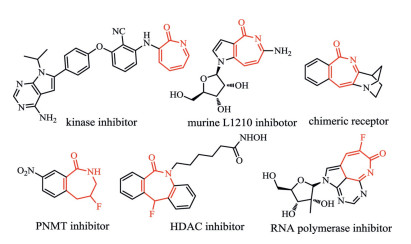
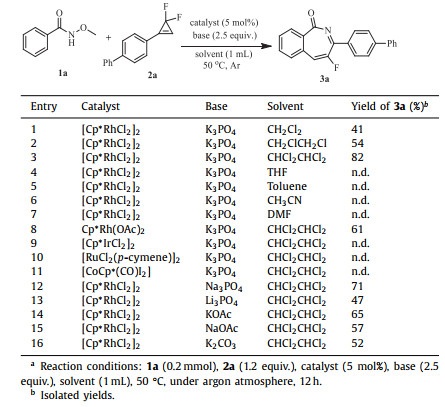
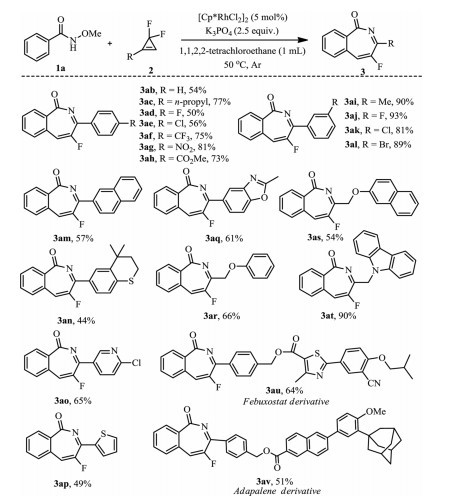


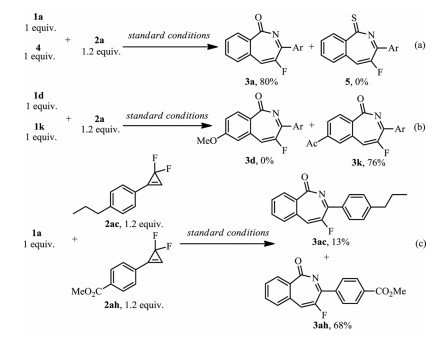
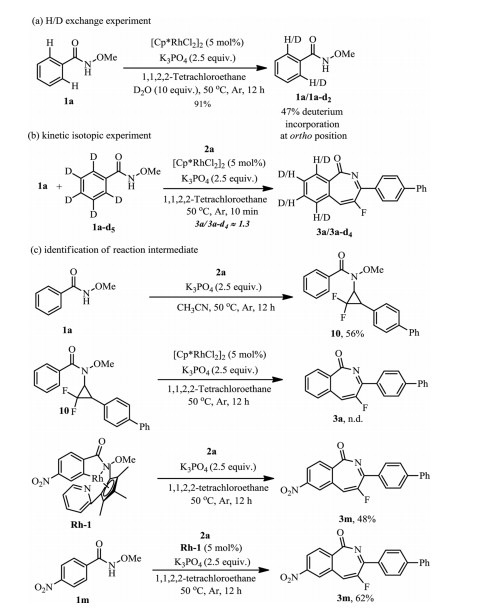
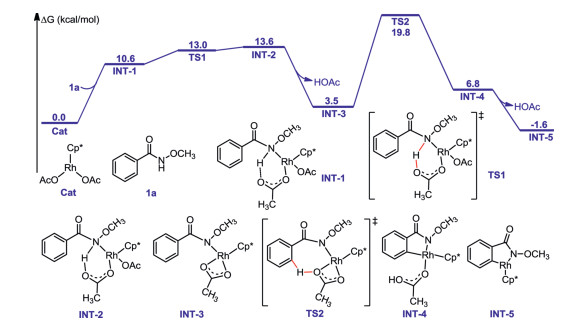
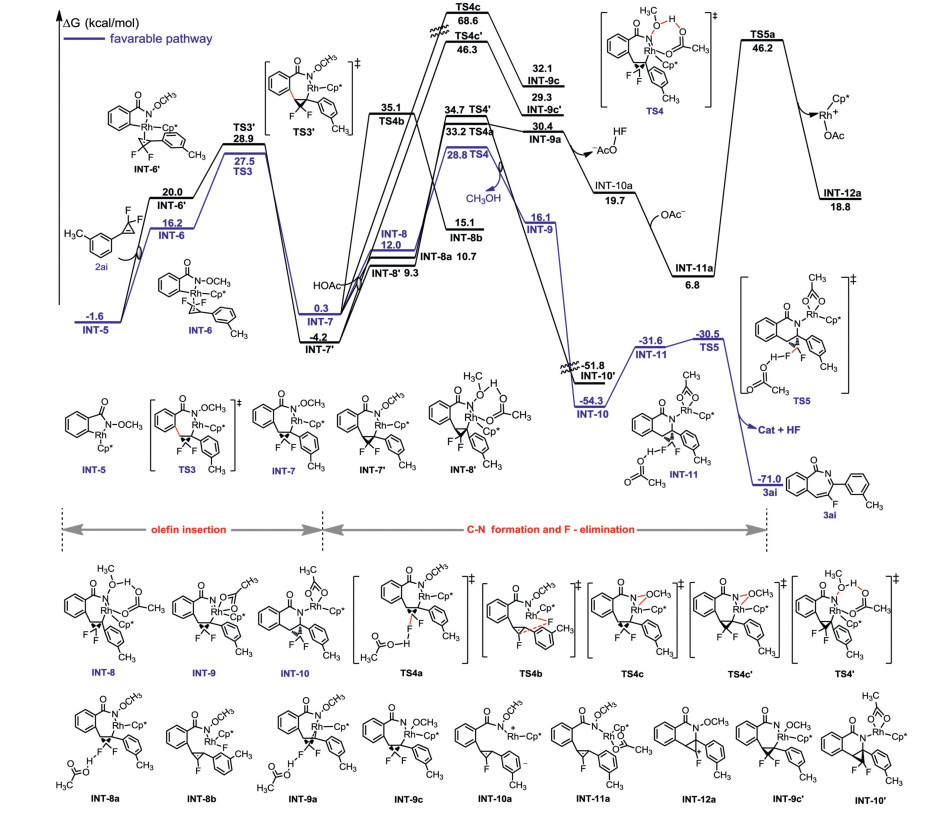
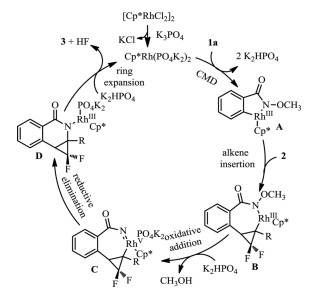
 DownLoad:
DownLoad: